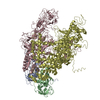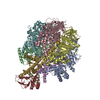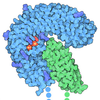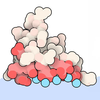+ Open data
Open data
- Basic information
Basic information
| Entry | Database: EMDB / ID: EMD-6991 | ||||||||||||
|---|---|---|---|---|---|---|---|---|---|---|---|---|---|
| Title | Structure of the human PKD1/PKD2 complex | ||||||||||||
 Map data Map data | None | ||||||||||||
 Sample Sample |
| ||||||||||||
 Keywords Keywords | Asymmetric complex / polycystic kidney disease / MEMBRANE PROTEIN | ||||||||||||
| Function / homology |  Function and homology information Function and homology informationmetanephric distal tubule morphogenesis / detection of nodal flow / metanephric smooth muscle tissue development / metanephric cortex development / metanephric cortical collecting duct development / metanephric distal tubule development / polycystin complex / mesonephric tubule development / mesonephric duct development / metanephric part of ureteric bud development ...metanephric distal tubule morphogenesis / detection of nodal flow / metanephric smooth muscle tissue development / metanephric cortex development / metanephric cortical collecting duct development / metanephric distal tubule development / polycystin complex / mesonephric tubule development / mesonephric duct development / metanephric part of ureteric bud development / determination of liver left/right asymmetry / renal tubule morphogenesis / metanephric ascending thin limb development / HLH domain binding / lung epithelium development / mitocytosis / lymph vessel morphogenesis / metanephric mesenchyme development / metanephric S-shaped body morphogenesis / renal artery morphogenesis / basal cortex / metanephric proximal tubule development / positive regulation of inositol 1,4,5-trisphosphate-sensitive calcium-release channel activity / migrasome / calcium-independent cell-matrix adhesion / Wnt receptor activity / cilium organization / VxPx cargo-targeting to cilium / genitalia development / establishment of epithelial cell polarity / detection of mechanical stimulus / calcium-induced calcium release activity / voltage-gated monoatomic ion channel activity / muscle alpha-actinin binding / cation channel complex / regulation of calcium ion import / placenta blood vessel development / response to fluid shear stress / Golgi-associated vesicle membrane / cellular response to hydrostatic pressure / digestive tract development / outward rectifier potassium channel activity / cellular response to fluid shear stress / metanephric collecting duct development / non-motile cilium / cellular response to osmotic stress / actinin binding / voltage-gated monoatomic cation channel activity / motile cilium / transcription regulator inhibitor activity / aorta development / determination of left/right symmetry / cartilage development / inorganic cation transmembrane transport / voltage-gated sodium channel activity / neural tube development / ciliary membrane / protein heterotetramerization / cartilage condensation / branching involved in ureteric bud morphogenesis / skin development / negative regulation of G1/S transition of mitotic cell cycle / branching morphogenesis of an epithelial tube / spinal cord development / heart looping / homophilic cell adhesion via plasma membrane adhesion molecules / negative regulation of ryanodine-sensitive calcium-release channel activity / cytoplasmic side of endoplasmic reticulum membrane / regulation of G1/S transition of mitotic cell cycle / centrosome duplication / cell surface receptor signaling pathway via JAK-STAT / voltage-gated potassium channel activity / potassium channel activity / lateral plasma membrane / anatomical structure morphogenesis / embryonic placenta development / voltage-gated calcium channel activity / sodium ion transmembrane transport / regulation of cell adhesion / monoatomic cation channel activity / regulation of proteasomal protein catabolic process / regulation of mitotic spindle organization / cellular response to cAMP / release of sequestered calcium ion into cytosol / calcium channel complex / cytoskeletal protein binding / potassium ion transmembrane transport / protein export from nucleus / cell-matrix adhesion / cellular response to calcium ion / liver development / basal plasma membrane / kidney development / ciliary basal body / establishment of localization in cell / phosphoprotein binding / lumenal side of endoplasmic reticulum membrane / protein tetramerization / calcium ion transmembrane transport / cytoplasmic vesicle membrane Similarity search - Function | ||||||||||||
| Biological species |  Homo sapiens (human) Homo sapiens (human) | ||||||||||||
| Method | single particle reconstruction / cryo EM / Resolution: 3.6 Å | ||||||||||||
 Authors Authors | Su Q / Hu F / Ge X / Lei J / Yu S / Wang T / Zhou Q / Mei C / Shi Y | ||||||||||||
| Funding support |  China, 3 items China, 3 items
| ||||||||||||
 Citation Citation |  Journal: Science / Year: 2018 Journal: Science / Year: 2018Title: Structure of the human PKD1-PKD2 complex. Authors: Qiang Su / Feizhuo Hu / Xiaofei Ge / Jianlin Lei / Shengqiang Yu / Tingliang Wang / Qiang Zhou / Changlin Mei / Yigong Shi /  Abstract: Mutations in two genes, and , account for most cases of autosomal dominant polycystic kidney disease, one of the most common monogenetic disorders. Here we report the 3.6-angstrom cryo-electron ...Mutations in two genes, and , account for most cases of autosomal dominant polycystic kidney disease, one of the most common monogenetic disorders. Here we report the 3.6-angstrom cryo-electron microscopy structure of truncated human PKD1-PKD2 complex assembled in a 1:3 ratio. PKD1 contains a voltage-gated ion channel (VGIC) fold that interacts with PKD2 to form the domain-swapped, yet noncanonical, transient receptor potential (TRP) channel architecture. The S6 helix in PKD1 is broken in the middle, with the extracellular half, S6a, resembling pore helix 1 in a typical TRP channel. Three positively charged, cavity-facing residues on S6b may block cation permeation. In addition to the VGIC, a five-transmembrane helix domain and a cytosolic PLAT domain were resolved in PKD1. The PKD1-PKD2 complex structure establishes a framework for dissecting the function and disease mechanisms of the PKD proteins. | ||||||||||||
| History |
|
- Structure visualization
Structure visualization
| Movie |
 Movie viewer Movie viewer |
|---|---|
| Structure viewer | EM map:  SurfView SurfView Molmil Molmil Jmol/JSmol Jmol/JSmol |
| Supplemental images |
- Downloads & links
Downloads & links
-EMDB archive
| Map data |  emd_6991.map.gz emd_6991.map.gz | 58.7 MB |  EMDB map data format EMDB map data format | |
|---|---|---|---|---|
| Header (meta data) |  emd-6991-v30.xml emd-6991-v30.xml emd-6991.xml emd-6991.xml | 14.5 KB 14.5 KB | Display Display |  EMDB header EMDB header |
| Images |  emd_6991.png emd_6991.png | 238.9 KB | ||
| Filedesc metadata |  emd-6991.cif.gz emd-6991.cif.gz | 6.4 KB | ||
| Archive directory |  http://ftp.pdbj.org/pub/emdb/structures/EMD-6991 http://ftp.pdbj.org/pub/emdb/structures/EMD-6991 ftp://ftp.pdbj.org/pub/emdb/structures/EMD-6991 ftp://ftp.pdbj.org/pub/emdb/structures/EMD-6991 | HTTPS FTP |
-Validation report
| Summary document |  emd_6991_validation.pdf.gz emd_6991_validation.pdf.gz | 571.6 KB | Display |  EMDB validaton report EMDB validaton report |
|---|---|---|---|---|
| Full document |  emd_6991_full_validation.pdf.gz emd_6991_full_validation.pdf.gz | 571.1 KB | Display | |
| Data in XML |  emd_6991_validation.xml.gz emd_6991_validation.xml.gz | 6.1 KB | Display | |
| Data in CIF |  emd_6991_validation.cif.gz emd_6991_validation.cif.gz | 7 KB | Display | |
| Arichive directory |  https://ftp.pdbj.org/pub/emdb/validation_reports/EMD-6991 https://ftp.pdbj.org/pub/emdb/validation_reports/EMD-6991 ftp://ftp.pdbj.org/pub/emdb/validation_reports/EMD-6991 ftp://ftp.pdbj.org/pub/emdb/validation_reports/EMD-6991 | HTTPS FTP |
-Related structure data
| Related structure data |  6a70MC  6992C C: citing same article ( M: atomic model generated by this map |
|---|---|
| Similar structure data | |
| EM raw data |  EMPIAR-10262 (Title: Structure of the human PKD1-PKD2 complex / Data size: 209.8 EMPIAR-10262 (Title: Structure of the human PKD1-PKD2 complex / Data size: 209.8 Data #1: Autopicked particles of PKD1/PKD2 complex [picked particles - multiframe - unprocessed]) |
- Links
Links
| EMDB pages |  EMDB (EBI/PDBe) / EMDB (EBI/PDBe) /  EMDataResource EMDataResource |
|---|---|
| Related items in Molecule of the Month |
- Map
Map
| File |  Download / File: emd_6991.map.gz / Format: CCP4 / Size: 64 MB / Type: IMAGE STORED AS FLOATING POINT NUMBER (4 BYTES) Download / File: emd_6991.map.gz / Format: CCP4 / Size: 64 MB / Type: IMAGE STORED AS FLOATING POINT NUMBER (4 BYTES) | ||||||||||||||||||||||||||||||||||||||||||||||||||||||||||||
|---|---|---|---|---|---|---|---|---|---|---|---|---|---|---|---|---|---|---|---|---|---|---|---|---|---|---|---|---|---|---|---|---|---|---|---|---|---|---|---|---|---|---|---|---|---|---|---|---|---|---|---|---|---|---|---|---|---|---|---|---|---|
| Annotation | None | ||||||||||||||||||||||||||||||||||||||||||||||||||||||||||||
| Projections & slices | Image control
Images are generated by Spider. | ||||||||||||||||||||||||||||||||||||||||||||||||||||||||||||
| Voxel size | X=Y=Z: 1.091 Å | ||||||||||||||||||||||||||||||||||||||||||||||||||||||||||||
| Density |
| ||||||||||||||||||||||||||||||||||||||||||||||||||||||||||||
| Symmetry | Space group: 1 | ||||||||||||||||||||||||||||||||||||||||||||||||||||||||||||
| Details | EMDB XML:
CCP4 map header:
| ||||||||||||||||||||||||||||||||||||||||||||||||||||||||||||
-Supplemental data
- Sample components
Sample components
-Entire : the structure of an asymmetric complex
| Entire | Name: the structure of an asymmetric complex |
|---|---|
| Components |
|
-Supramolecule #1: the structure of an asymmetric complex
| Supramolecule | Name: the structure of an asymmetric complex / type: complex / ID: 1 / Parent: 0 / Macromolecule list: all Details: Samples were obtained by co-expression in 293F cells. A complex contains one PKD1 subunit and three PKD2 subunits. |
|---|---|
| Source (natural) | Organism:  Homo sapiens (human) Homo sapiens (human) |
| Molecular weight | Theoretical: 310 KDa |
-Macromolecule #1: Polycystin-2
| Macromolecule | Name: Polycystin-2 / type: protein_or_peptide / ID: 1 / Number of copies: 3 / Enantiomer: LEVO |
|---|---|
| Source (natural) | Organism:  Homo sapiens (human) Homo sapiens (human) |
| Molecular weight | Theoretical: 66.623406 KDa |
| Recombinant expression | Organism:  HOMO SAPIENS (human) HOMO SAPIENS (human) |
| Sequence | String: MGSAGWSHPQ FEKGGGSGGG SGGSAWSHPQ FEKGSAAAPR VAWAERLVRG LRGLWGTRLM EESSTNREKY LKSVLRELVT YLLFLIVLC ILTYGMMSSN VYYYTRMMSQ LFLDTPVSKT EKTNFKTLSS MEDFWKFTEG SLLDGLYWKM QPSNQTEADN R SFIFYENL ...String: MGSAGWSHPQ FEKGGGSGGG SGGSAWSHPQ FEKGSAAAPR VAWAERLVRG LRGLWGTRLM EESSTNREKY LKSVLRELVT YLLFLIVLC ILTYGMMSSN VYYYTRMMSQ LFLDTPVSKT EKTNFKTLSS MEDFWKFTEG SLLDGLYWKM QPSNQTEADN R SFIFYENL LLGVPRIRQL RVRNGSCSIP QDLRDEIKEC YDVYSVSSED RAPFGPRNGT AWIYTSEKDL NGSSHWGIIA TY SGAGYYL DLSRTREETA AQVASLKKNV WLDRGTRATF IDFSVYNANI NLFCVVRLLV EFPATGGVIP SWQFQPLKLI RYV TTFDFF LAACEIIFCF FIFYYVVEEI LEIRIHKLHY FRSFWNCLDV VIVVLSVVAI GINIYRTSNV EVLLQFLEDQ NTFP NFEHL AYWQIQFNNI AAVTVFFVWI KLFKFINFNR TMSQLSTTMS RCAKDLFGFA IMFFIIFLAY AQLAYLVFGT QVDDF STFQ ECIFTQFRII LGDINFAEIE EANRVLGPIY FTTFVFFMFF ILLNMFLAII NDTYSEVKSD LAQQKAEMEL SDLIRK GYH KALVKLKLKK NTVD UniProtKB: Polycystin-2 |
-Macromolecule #2: Polycystin-1
| Macromolecule | Name: Polycystin-1 / type: protein_or_peptide / ID: 2 / Number of copies: 1 / Enantiomer: LEVO |
|---|---|
| Source (natural) | Organism:  Homo sapiens (human) Homo sapiens (human) |
| Molecular weight | Theoretical: 127.024836 KDa |
| Recombinant expression | Organism:  HOMO SAPIENS (human) HOMO SAPIENS (human) |
| Sequence | String: MGSAGDYKDH DGDYKDHDID YKDDDDKGSA AATAFGASLF VPPSHVRFVF PEPTADVNYI VMLTCAVCLV TYMVMAAILH KLDQLDASR GRAIPFCGQR GRFKYEILVK TGWGRGSGTT AHVGIMLYGV DSRSGHRHLD GDRAFHRNSL DIFRIATPHS L GSVWKIRV ...String: MGSAGDYKDH DGDYKDHDID YKDDDDKGSA AATAFGASLF VPPSHVRFVF PEPTADVNYI VMLTCAVCLV TYMVMAAILH KLDQLDASR GRAIPFCGQR GRFKYEILVK TGWGRGSGTT AHVGIMLYGV DSRSGHRHLD GDRAFHRNSL DIFRIATPHS L GSVWKIRV WHDNKGLSPA WFLQHVIVRD LQTARSAFFL VNDWLSVETE ANGGLVEKEV LAASDAALLR FRRLLVAELQ RG FFDKHIW LSIWDRPPRS RFTRIQRATC CVLLICLFLG ANAVWYGAVG DSAYSTGHVS RLSPLSVDTV AVGLVSSVVV YPV YLAILF LFRMSRSKVA GSPSPTPAGQ QVLDIDSCLD SSVLDSSFLT FSGLHAEQAF VGQMKSDLFL DDSKSLVCWP SGEG TLSWP DLLSDPSIVG SNLRQLARGQ AGHGLGPEED GFSLASPYSP AKSFSASDED LIQQVLAEGV SSPAPTQDTH METDL LSSL SSTPGEKTET LALQRLGELG PPSPGLNWEQ PQAARLSRTG LVEGLRKRLL PAWCASLAHG LSLLLVAVAV AVSGWV GAS FPPGVSVAWL LSSSASFLAS FLGWEPLKVL LEALYFSLVA KRLHPDEDDT LVESPAVTPV SARVPRVRPP HGFALFL AK EEARKVKRLH GMLRSLLVYM LFLLVTLLAS YGDASCHGHA YRLQSAIKQE LHSRAFLAIT RSEELWPWMA HVLLPYVH G NQSSPELGPP RLRQVRLQEA LYPDPPGPRV HTCSAAGGFS TSDYDVGWES PHNGSGTWAY SAPDLLGAWS WGSCAVYDS GGYVQELGLS LEESRDRLRF LQLHNWLDNR SRAVFLELTR YSPAVGLHAA VTLRLEFPAA GRALAALSVR PFALRRLSAG LSLPLLTSV CLLLFAVHFA VAEARTWHRE GRWRVLRLGA WARWLLVALT AATALVRLAQ LGAADRQWTR FVRGRPRRFT S FDQVAQLS SAARGLAASL LFLLLVKAAQ QLRFVRQWSV FGKTLCRALP ELLGVTLGLV VLGVAYAQLA ILLVSSCVDS LW SVAQALL VLCPGTGLST LCPAESWHLS PLLCVGLWAL RLWGALRLGA VILRWRYHAL RGELYRPAWE PQDYEMVELF LRR LRLWMG LSKVKEFRHK VRFEGMEPLP SRSSRGS UniProtKB: Polycystin-1 |
-Experimental details
-Structure determination
| Method | cryo EM |
|---|---|
 Processing Processing | single particle reconstruction |
| Aggregation state | particle |
- Sample preparation
Sample preparation
| Concentration | 10 mg/mL | ||||||||||||
|---|---|---|---|---|---|---|---|---|---|---|---|---|---|
| Buffer | pH: 7.5 Component:
| ||||||||||||
| Grid | Model: Quantifoil R1.2/1.3 / Material: GOLD / Mesh: 300 / Support film - Material: CARBON / Pretreatment - Type: GLOW DISCHARGE / Pretreatment - Time: 30 sec. | ||||||||||||
| Vitrification | Cryogen name: ETHANE / Chamber humidity: 100 % / Chamber temperature: 281 K / Instrument: FEI VITROBOT MARK IV | ||||||||||||
| Details | This sample was monodisperse. |
- Electron microscopy
Electron microscopy
| Microscope | FEI TITAN KRIOS |
|---|---|
| Image recording | Film or detector model: GATAN K2 SUMMIT (4k x 4k) / Average electron dose: 50.0 e/Å2 |
| Electron beam | Acceleration voltage: 300 kV / Electron source:  FIELD EMISSION GUN FIELD EMISSION GUN |
| Electron optics | Illumination mode: FLOOD BEAM / Imaging mode: DARK FIELD |
| Experimental equipment |  Model: Titan Krios / Image courtesy: FEI Company |
- Image processing
Image processing
| Startup model | Type of model: PDB ENTRY PDB model - PDB ID: |
|---|---|
| Final reconstruction | Resolution.type: BY AUTHOR / Resolution: 3.6 Å / Resolution method: FSC 0.143 CUT-OFF / Number images used: 27296 |
| Initial angle assignment | Type: ANGULAR RECONSTITUTION |
| Final angle assignment | Type: ANGULAR RECONSTITUTION |
 Movie
Movie Controller
Controller























 Z (Sec.)
Z (Sec.) Y (Row.)
Y (Row.) X (Col.)
X (Col.)






















